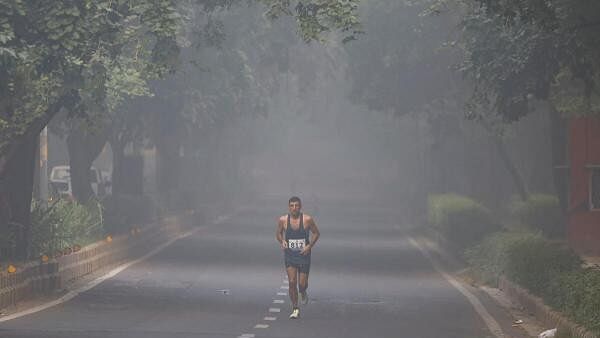
A man jogs as he participates in a marathon while the sky is enveloped with smog after Delhi’s air quality was classified as "hazardous" amidst severe air pollution, in New Delhi
Credit: PTI Photo
New Delhi: With Delhi’s air quality in the "severe" zone for the second consecutive day, the Commission for Air Quality Management on Thursday imposed a set of the stringent regulatory measures including a complete halt on construction and demolition activities while directing the authorities to stop a large number of inter-state buses and trucks outside the national capital.
Following the CAQM order, the Delhi government asked all schools to discontinue physical attendance from Friday 8 am for children up to class 5, who would be taught online. All other emergency measures will kick in at the same time.
The commission asked the local administrations to take a call on schools in Noida, Greater Noida, Gurugram, Ghaziabad and Faridabad even as the toxic haze engulfed the national capital region for the better part of the day.
The commission had advised the common people to use cycles or walks for short trips and combine errands to reduce the number of trips.
Almost all types of construction activities excluding a few government ones will stop. Interstate buses not running on clean fuel have been asked to terminate outside Delhi. There will be severe restrictions on the movement of goods vehicles.
The introduction of GARP-III happened on a day when Delhi’s air quality index was 424 in a scale of 500 at 4 pm. This, according to the Central Pollution Control Board, is the “severe” category of air pollution.
“Unfavorable meteorological conditions, including dense fog and north-westerly winds moving the pollutants (caused by stubble burning) to Delhi are the major causes for sudden spike in AQI,” a Union Environment Ministry official said.
Last year GARP-III was introduced on Nov 2 whereas this year it took another 12 days for Delhi air to reach such a critical stage, he said, noting that weather conditions were better during the Diwali period and subsequent ten days.
Environmentalists outside the government, however, blame the national capital’s huge vehicle load as the root cause of a very high baseline air pollution level, which gets aggravated during the winter due to stubble burning and temperature drop.
A recent analysis by the Centre for Science and Environment shows that nearly one-third of Delhi’s winter pollution comes from local sources with more than 50% contribution from the transport sector.
The remaining two-third is contributed by other NCR cities like Noida, Greater Noida, Gurgaon, Faridabad and Ghaziabad; and districts outside the NCR like those in Punjab and Haryana where farmers put fields on fire to get rid of paddy stubble.
The air quality index for other NCR cities lies in the “very poor” category with the weather bureau offering no hope for any immediate improvement.
The India Meteorological Department said dense to very dense fog would continue for the next few days and temperature will drop further.
The GRAP for Delhi-NCR is divided into four stages of air quality - stage 1 for "poor" AQI ranging between 201 and 300; stage 2 for “very poor” AQI of 301-400; stage 3 for “severe” AQI of 401-450 and stage 4 for "severe plus" AQI (more than 450).
